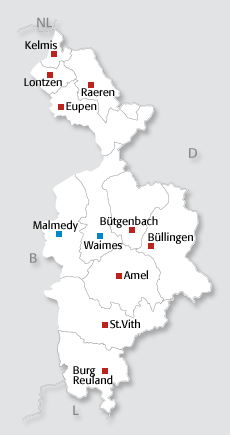St.Vith’s history
 The town of St. Vith is first mentioned in documents dating from the 12th century, a customs location was constructed here by the dukes of Limburg in 1151. In 1271, St. Vith was sold to Walram the Red of the house Valkemburg-Montjoie, as a Luxembourg fiefdom. Under the dominion of Johann von Valkenburg-Montjoie, the market town was fortified around 1350. Expansion of the castle and construction of the city wall with guard towers.
The town of St. Vith is first mentioned in documents dating from the 12th century, a customs location was constructed here by the dukes of Limburg in 1151. In 1271, St. Vith was sold to Walram the Red of the house Valkemburg-Montjoie, as a Luxembourg fiefdom. Under the dominion of Johann von Valkenburg-Montjoie, the market town was fortified around 1350. Expansion of the castle and construction of the city wall with guard towers.Since St. Vith’s connection with Viancen, the significance of the city increased under the count of Sponheim and the count of Nassau. It became an economic (market town), administrative (high court, was seat of stewards and bailiffs) and military (home of a garrison) center and was a strategically important point on the northern border to Luxembourg.
The economic boom was interrupted throughout the centuries by sieges, destruction during war, fires and pestilence. The pestilence in the mid-14th century claimed a large part of the population of St. Vith. In the 16th century, fires destroyed the city several times, documented in 1517 and prior to 1541. Duke Wilhelm of Jülich, an ally of the French king, burned down the city in 1543. 1689 it was ruined by King Louis XIV and burned down. Six years later, a fierce fire again destroyed the newly constructed homes.
With the Peace of Aachen (1748), the Austrian Heir to the Throne, Maria-Theresia, accepted sovereignty of the Luxembourg country. Her rule coincides with the founding of the St. Vith leather industry.
1794, during the French-Austrian war, the French occupied the area of what is today Belgium and the area of St. Vith. The city was henceforth the seat of a “Mairie“ (Town Hall) and formed the canton St. Vith, jointly with the surrounding town halls, which was part of the Arrondissement Malmedy within the Département de l' Ourthe.
Up until Napoleonic times, St. Vith was part of Luxembourg but was allocated to Prussia with the Vienna Congress of 1815. After World War I, except for the time period of 1940 to 1945, it has belonged to Belgium. It was completely destroyed during the Ardennes Offensive of 1944.

